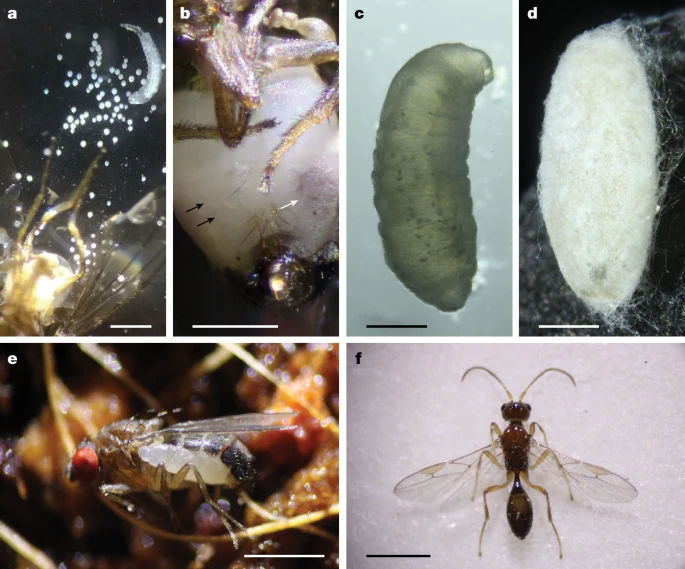Nature is Metal
-
A team of biologists recently discovered a new parasitic wasp species in the United States that has a unique way of infecting its hosts. Syntretus perlmani lays its eggs in the bodies of living, adult fruit flies instead of larvae or pupae. The wasp larvae then burst out of the fly’s abdomen, killing it.
https://www.nature.com/articles/s41586-024-07919-7

a,b, The development of wasp larvae inside host flies (a) is accompanied by growth of wasp teratocytes (b, black arrows), which can be seen through the host abdominal cuticle and obstruct the view of the testes (b, white arrow). c, The second and following larval instars lack a head capsule and tail spike, and the final instar grows to nearly the length of the host fly (see Supplementary Video 2). d, Pupal development takes place within a white silken cocoon as is typical of euphorine wasps. e, Larval emergence is always from the abdomen and has been observed to occur between the second and third tergites (dorsolaterally) or laterally through a tear in the abdominal cuticle. f, The adult wasp (male shown) is small, yellowish brown and approximately 1.5 mm in length. Scale bars, 0.5 mm (a–d) and 1 mm (e,f). -
-
Kind of disgusting but at the same time, a bit interesting.
A japanese leech eating a worm
Link to video -
@jon-nyc said in Nature is Metal:
I wonder how long that worm stayed alive after being consumed whole.
After that decapitated snake head that bit its own tail, I'm wondering whether there is a bright line between alive and dead for lower creatures like worms or magats.
-
@jon-nyc I liked how it kind of bobbed its head to find it. I guess it was using "smell" or the equivalent because I dont think it has eyes.
-
https://www.instagram.com/p/DFa9zL0SWVF/
Aquarium in CHina.
(PS You should be able to watch even if you dont have IG. I dont have it, and I was able to see)
-
@Mik said in Nature is Metal:
...after a prolonged 20 minute struggle, the snake finally relents,
LOL
